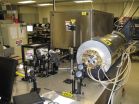INFORMATION:
In addition to researchers from the National Institutes of Health and LSU Health New Orleans, scientists from the Food and Drug Administration, Harvard Medical School, Cincinnati Children's Hospital Medical Center and the University of Alabama Birmingham also participated.
The research was supported by grants from the National Institute of Allergy and
Infectious Diseases, National Eye Institute, Research to Prevent Blindness Senior Investigator Award, LSU Health Sciences Center New Orleans, the Louisiana Lions Eye Foundation and U.S. Food and Drug Administration Intramural Funding.
LSU Health Sciences Center New Orleans educates Louisiana's health care professionals. The state's health university leader, LSU Health New Orleans includes a School of Medicine, the state's only School of Dentistry, Louisiana's only public School of Public Health, and Schools of Allied Health Professions, Nursing, and Graduate Studies. LSU Health New Orleans faculty take care of patients in public and private hospitals and clinics throughout the region. In the vanguard of biosciences research in a number of areas in a worldwide arena, the LSU Health New Orleans research enterprise generates jobs and enormous economic impact. LSU Health New Orleans faculty have made lifesaving discoveries and continue to work to prevent, advance treatment, or cure disease. To learn more, visit http://www.lsuhsc.edu, http://www.twitter.com/LSUHealthNO, or http://www.facebook.com/LSUHSC.
Study discovers RX approach that reduces herpes virus infection
2014-12-03
(Press-News.org) New Orleans, LA - A multi-institutional study reports an effective treatment approach to inhibit and keep latent viruses like herpes simplex from reactivating and causing disease. The work, whose lead author is the late James Hill, PhD, LSU Health New Orleans Professor and Director of Pharmacology and Infectious Disease at the LSU Eye Center, is published in the December 3, 2014, issue of Science Translational Medicine.
The research team, led by Thomas M. Kristie, PhD, Chief of the Molecular Genetics Section in the National Institute of Allergy and Infectious Diseases' Laboratory of Viral Diseases, and also included Timothy Foster, PhD, LSU Health New Orleans Associate Professor of Microbiology, Immunology & Parasitology, studied herpes simplex virus (HSV) infection in several animal models. They found that an existing drug, tranylcypromine (TCP), blocked a protein called LSD1, which plays a major role in the initiation of herpes simplex virus infection. Current treatments require active viral replication and target late stages of infection, which has led to the development of drug resistance. This study took a different approach - targeting a drug to a protein that controls how genes are turned on and off, early in the viral replication process. This "epigenetic" approach not only reduced symptoms, but unlike existing treatments, also reduced shedding (the release of virus particles which can transmit the virus even in the absence of symptoms) and forced the virus to remain in a latent stage, preventing its reactivation. Results indicate that even when a virus is not active, drugs modulating epigenetic changes can still treat the infection. Researchers have been pursuing epigenetic-based therapies for cancer, and this study demonstrates its potential as effective antiviral therapy, too.
A high percentage of the human population is infected with the herpes simplex virus and carries the virus in a latent state. After the initial infection, HSV typically goes dormant in cells where it remains. It can then reactivate with a recurrence of symptoms. Even when latent, asymptomatic shedding of the virus continues its transmission. Neonatal HSV infections can result in death or developmental-neurological issues. HSV eye infections and recurrences are the leading viral cause of infectious blindness or the need for corneal transplants. In addition, along with other herpesviruses, HSV is a complicating factor in immunosuppressed individuals and is a cofactor in HIV transmission.
Although he died before the study was published, LSU Health New Orleans professor Dr. James M. Hill participated in the research. "Dr. Hill was a distinguished and respected herpesvirologist/animal model scientist who passed away approximately a year ago," notes Dr. Foster. "He is lead author on this manuscript due to both his contributions to the work and out of honor and respect for his contributions to the field and all of us involved."
ELSE PRESS RELEASES FROM THIS DATE:
New study shows computer-based approach to treating anxiety may reduce suicide risk
2014-12-03
TALLAHASSEE, Fla. -- A group of psychology researchers at Florida State University have developed a simple computer-based approach to treating anxiety sensitivity, something that could have major implications for veterans and other groups who are considered at risk for suicide.
"We have been using computer-delivered interventions for many years now in an effort to more efficiently deliver effective treatments," said psychology Professor Brad Schmidt, director of the Anxiety and Behavioral Health Clinic. "This study gives us evidence that a brief intervention may help ...
Satellite time-lapse movie shows California soaker
2014-12-03
VIDEO:
A new time-lapse animation of data from NOAA's GOES-West satellite provides a good picture of why the U.S. West Coast continues to experience record rainfall. The new animation shows the...
Click here for more information.
A new time-lapse animation of data from NOAA's GOES-West satellite provides a good picture of why the U.S. West Coast continues to experience record rainfall. The new animation shows the movement of storms from Nov. 30 to Dec. 3.
NOAA's Geostationary ...
PET scans help identify effective TB drugs, says Pitt School of Medicine study
2014-12-03
PITTSBURGH, Dec. 3, 2014 - Sophisticated lung imaging can show whether or not a treatment drug is able to clear tuberculosis (TB) lung infection in human and macaque studies, according to researchers at the University of Pittsburgh School of Medicine and their international collaborators.
The findings, published online today in Science Translational Medicine, indicate the animal model can correctly predict which experimental agents have the best chance for success in human trials.
The image on the left shows "hot spots" of infection in a patient's lungs before treatment. ...
Arabian Sea humpback whales isolated for 70,000 years
2014-12-03
Scientists from WCS (Wildlife Conservation Society), the American Museum of Natural History (AMNH), the Environment Society of Oman, and other organizations have made a fascinating discovery in the northern Indian Ocean: humpback whales inhabiting the Arabian Sea are the most genetically distinct humpback whales in the world and may be the most isolated whale population on earth. The results suggest they have remained separate from other humpback whale populations for perhaps 70,000 years, extremely unusual in a species famed for long distance migrations.
The study appears ...
Creating a better health care experience for lesbian, bisexual women
2014-12-03
PULLMAN, Wash. - Sitting on an exam table in a flimsy gown can intimidate anyone. If you also happen to be lesbian, gay or bisexual, the experience can be even worse.
As a woman of sexual minority, Nicole Flemmer has encountered medical misinformation and false assumptions. She was once diagnosed with "ego dystonic homosexuality" - a long-discredited term - without her knowledge or an appropriate discussion with the doctor. She discovered the notation years later when she happened to glance at her medical chart.
Such experiences left her hesitant to access health ...
Toxin from tobacco smoke could increase pain in spinal cord injury
2014-12-03
WEST LAFAYETTE, Ind. - A neurotoxin called acrolein found in tobacco smoke that is thought to increase pain in people with spinal cord injury has now been shown to accumulate in mice exposed to the equivalent of 12 cigarettes daily over a short time period.
One implication is that if acrolein is exacerbating pain its concentration in the body could be reduced using the drug hydralazine, which has been approved by the U.S. Food and Drug Administration for hypertension, said Riyi Shi (pronounced Ree Shee), a professor in Purdue University's Department of Basic Medical Sciences, ...
Citizen science increases environmental awareness, advocacy
2014-12-03
DURHAM, N.C. -- Citizens who get involved in science become more environmentally aware and willing to participate in advocacy than previously thought, according to a new study by researchers at Duke University's Nicholas School of the Environment. Citizen science projects can lead to broader public support for conservation efforts.
The study, led by PhD student McKenzie Johnson, appeared in November in the journal Global Environmental Change. It surveyed 115 people who had recently participated in citizen science projects in India with the Wildlife Conservation Society ...
Reducing drug allergies without compromising efficacy
2014-12-03
An enzyme that usually triggers strong allergic reactions now circulates in the veins of a group of mice without alerting the immune system. As INRS Énergie Matériaux Télécommunications Research Centre Professor Marc A. Gauthier explains in an article published in the journal Nature Communications, a polymer was used to camouflage the enzyme before it was injected into the rodents. This was achieved by coating the enzyme to avoid an immune response in a manner that does not compromise its activity. The first in vivo demonstration has opened the door ...
Laser sniffs out toxic gases from afar
2014-12-03
DURHAM, N.C. -- Scientists have developed a way to sniff out tiny amounts of toxic gases -- a whiff of nerve gas, for example, or a hint of a chemical spill -- from up to one kilometer away.
The new technology can discriminate one type of gas from another with greater specificity than most remote sensors -- even in complex mixtures of similar chemicals -- and under normal atmospheric pressure, something that wasn't thought possible before.
The researchers say the technique could be used to test for radioactive byproducts from nuclear accidents or arms control treaty ...
Study: How red wine prevents cancer
2014-12-03
Alcohol use is a major risk factor for head and neck cancer. But an article published in the November issue of the journal Advances in Experimental Medicine and Biology shows that the chemical resveratrol found in grape skins and in red wine may prevent cancer as well.
"Alcohol bombards your genes. Your body has ways to repair this damage, but with enough alcohol eventually some damage isn't fixed. That's why excessive alcohol use is a factor in head and neck cancer. Now, resveratrol challenges these cells - the ones with unrepaired DNA damage are killed, so they can't ...





